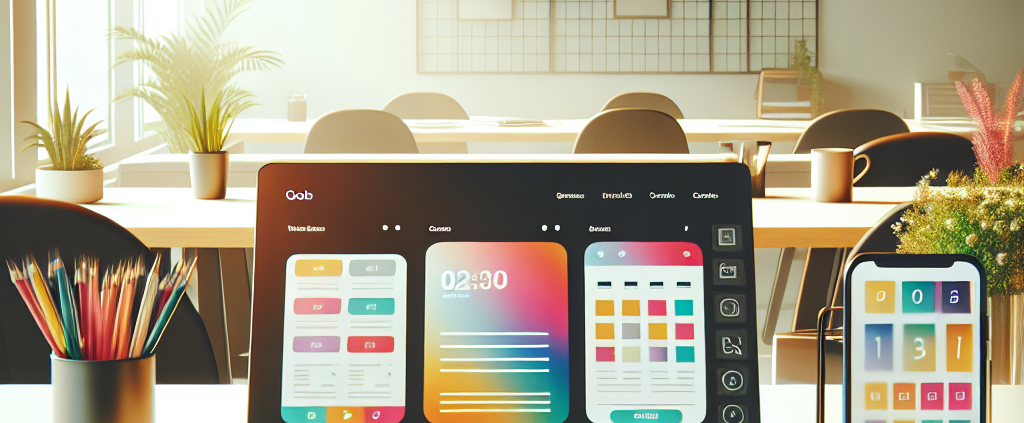Top Mobile App Development Hints You Need to Know
In today’s fast-paced digital world, mobile app development has become a cornerstone for businesses aiming to enhance their customer engagement and streamline operations. From startups to established enterprises, having a custom mobile app can significantly contribute to achieving strategic goals and staying competitive in the market. But where do you begin?
Mobile app development can seem daunting, especially with the myriad of options and technologies available. Understanding the basics is crucial for laying a strong foundation. A good starting point is defining the purpose of your app. Whether you aim to solve a specific problem, provide a unique service, or offer a new form of entertainment, clarity on your app’s purpose will guide the entire development process.
Another vital aspect is choosing the right platform. With Android and iOS being the dominant players, deciding whether to develop for one or both platforms is essential. Factors such as your target audience, budget, and desired features will influence this decision. Additionally, opting for native app development ensures better performance and user experience, leveraging the full potential of each platform’s capabilities.
Moreover, collaboration with an expert mobile app development team can make a significant difference. A professional team brings experience, technical know-how, and innovative solutions to the table, ensuring your app not only meets but exceeds expectations. At NS804, we specialize in transforming ideas into high-quality, high-performance apps tailored to your specific needs. Get a free quote today and take the first step towards making your app vision a reality.
Understanding User Needs and Preferences

One of the most critical aspects of mobile app development is understanding your users’ needs and preferences. A successful app is one that resonates with its users, solving their problems and providing value in a way that feels intuitive and engaging. To achieve this, you need to step into the shoes of your target audience.
Start by conducting thorough market research. This includes analyzing competitors, identifying gaps in the market, and understanding current trends. Surveys, interviews, and focus groups can provide valuable insights into what your potential users are looking for in a mobile app. Pay attention to their pain points, preferred features, and overall expectations.
Creating user personas can be particularly helpful. These are detailed profiles of your ideal users, encapsulating their demographics, behaviors, goals, and challenges. By having a clear picture of who you are developing for, you can tailor your app’s design and functionality to better meet their needs.
It’s also important to consider the user journey. Map out the various stages a user goes through when interacting with your app, from the moment they download it to their daily usage patterns. Identify any potential friction points and ensure that the user experience is as smooth and seamless as possible.
Finally, keep in mind that user needs and preferences can evolve over time. Regularly gathering feedback and monitoring usage analytics will help you stay aligned with user expectations and continuously improve your app. In the ever-changing landscape of mobile app development, staying attuned to your users is key to long-term success.
Designing an Intuitive User Interface

Designing an intuitive user interface (UI) is essential for the success of any mobile app. An intuitive UI ensures that users can easily navigate the app and accomplish their tasks without confusion or frustration. To achieve this, focus on simplicity, consistency, and feedback.
First, prioritize simplicity. A clean and straightforward design minimizes the learning curve for new users. Avoid clutter by using ample white space and limiting the number of elements on each screen. Users should be able to understand how to use your app at a glance. Simplified navigation structures, such as bottom navigation bars or hamburger menus, can help users find what they need quickly.
Consistency is another crucial factor. Maintain uniformity in design elements like colors, fonts, and button styles throughout the app. This cohesiveness creates a sense of familiarity, making it easier for users to predict how different parts of the app will behave. Leveraging established design patterns can also contribute to a more intuitive experience, as users will already be accustomed to these conventions.
Providing feedback is vital for user interaction. Whenever a user takes an action, such as tapping a button or submitting a form, the app should respond with visual or auditory feedback. This could include a color change, a sound, or a subtle animation. Such feedback reassures users that their actions have been registered and helps them understand the app’s outcomes.
Moreover, consider the importance of accessibility in UI design. Ensure your app is usable by people with varying abilities by incorporating features like scalable text, voice commands, and screen reader compatibility. Accessibility not only broadens your user base but also enhances the overall user experience.
By focusing on simplicity, consistency, feedback, and accessibility, you can design a user interface that feels intuitive and engaging. This, in turn, will significantly enhance user satisfaction and retention.
Ensuring High Performance and Speed

Ensuring high performance and speed in your mobile app is critical for user satisfaction and retention. Slow load times and unresponsive interfaces can quickly lead to user frustration and app abandonment. To optimize performance, consider several key strategies.
First, optimize your app’s loading time. Users expect apps to load within seconds, so minimize the initial load by reducing the size of assets, such as images and videos. Use compressed file formats and lazy loading techniques to ensure that content is only loaded when needed. This approach can significantly improve the app’s loading speed.
Next, focus on efficient data management. Inefficient data handling can cause delays and crashes. Implement data caching strategies to reduce server requests and load data more quickly. Use local storage options where appropriate to ensure that the app remains responsive even without a constant internet connection. Additionally, optimize your backend services to handle requests efficiently.
Another important aspect is minimizing battery consumption and memory usage. High battery drain and excessive memory usage can deter users from using your app. Optimize your code to run efficiently, and avoid unnecessary background processes. Regularly test your app on different devices to identify and fix performance bottlenecks.
Utilizing performance monitoring tools is also essential. These tools can help you track your app’s performance metrics in real-time, identify issues, and make data-driven improvements. Tools such as Firebase Performance Monitoring and New Relic Mobile provide insights into app performance, helping you pinpoint and resolve issues quickly.
Lastly, keep in mind the importance of regular updates and maintenance. Continuously monitor your app’s performance and release updates to fix bugs, improve speed, and introduce new features. Regular maintenance ensures that your app remains fast, reliable, and competitive in the market.
By implementing these strategies, you can ensure that your mobile app delivers high performance and speed, leading to a superior user experience and increased user retention.
Implementing Effective User Testing
Implementing effective user testing is a crucial step in the mobile app development process. It ensures that your app meets user expectations and functions smoothly across different devices and operating systems. User testing can uncover usability issues, bugs, and other potential problems before your app reaches the market, saving you time and resources in the long run.
Start by defining clear objectives for your user testing. Determine what aspects of the app you need to test, such as usability, performance, and functionality. Establish specific criteria for success to measure the app’s performance against these objectives. This focused approach will help you gather relevant feedback and make informed decisions.
Next, choose the right testing methods. There are various user testing techniques, including usability testing, beta testing, and A/B testing. Usability testing involves observing users as they interact with your app, providing insights into how intuitive and user-friendly your app is. Beta testing allows a select group of users to use the app in real-world conditions, helping identify any remaining issues. A/B testing compares different versions of the app to determine which one performs better in terms of user engagement and satisfaction.
Recruit a diverse group of testers that reflects your target audience. This diversity ensures that the feedback you receive is representative of your user base. Encourage testers to provide honest and detailed feedback, and make it easy for them to report issues or suggest improvements.
Analyze the feedback and data collected during the testing phase. Look for common trends and recurring issues that need to be addressed. Prioritize fixes based on the impact on user experience and the app’s overall performance. Implement the necessary changes and enhancements, and consider conducting another round of testing to verify that the issues have been resolved.
Regular user testing should be an ongoing part of your app development lifecycle. Continuous testing helps you stay ahead of potential problems, adapt to user needs, and maintain a high-quality app. By incorporating user feedback into your development process, you can create an app that truly resonates with your audience and stands out in the competitive app market.
Strategies for User Acquisition and Retention

Effective strategies for user acquisition and retention are essential for the long-term success of any mobile app. Acquiring new users and keeping them engaged ensures that your app not only grows but also maintains a loyal user base. Here are some key strategies to consider:
1. Optimize App Store Listings: Start by optimizing your app’s listing on both the Apple App Store and Google Play Store. Use relevant keywords, a compelling description, and high-quality screenshots to attract potential users. This will improve your app’s visibility and increase the chances of downloads.
2. Leverage Social Media: Social media platforms are powerful tools for user acquisition. Create engaging content that highlights the unique features and benefits of your app. Encourage user-generated content and leverage influencers to reach a broader audience.
3. Offer Incentives: Incentivize new users to try your app by offering special promotions, discounts, or rewards. Referral programs that reward existing users for bringing in new users can also be highly effective.
4. Personalize User Experience: Personalized experiences can significantly enhance user retention. Use data analytics to understand user behavior and preferences, and tailor content and notifications accordingly. Personalized recommendations and targeted promotions can keep users coming back to your app.
5. Provide Excellent Customer Support: Ensure that users have access to prompt and helpful customer support. Addressing issues quickly and effectively can improve user satisfaction and loyalty.
6. Regular Updates and Improvements: Continuously update your app with new features, bug fixes, and performance enhancements. Keeping your app fresh and up-to-date shows users that you are committed to providing a high-quality experience.
7. Analyze User Feedback: Actively seek and analyze user feedback to identify areas for improvement. Implementing user suggestions can make your app more appealing and user-friendly.
By combining these strategies, you can create a robust user acquisition and retention plan that drives app growth and ensures long-term success. Remember, the key to retaining users is to keep them engaged and satisfied with continuous value.
Ready to take your mobile app to the next level? Get a free quote from NS804 today and discover how our expert mobile app development services can help you achieve your goals.





Leave a Reply
Want to join the discussion?Feel free to contribute!